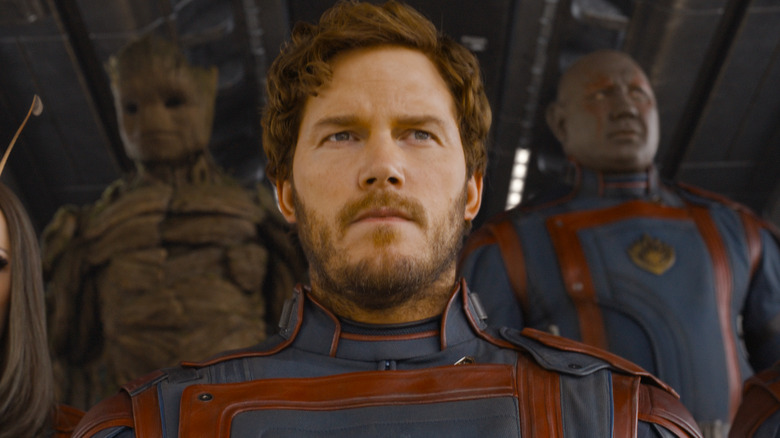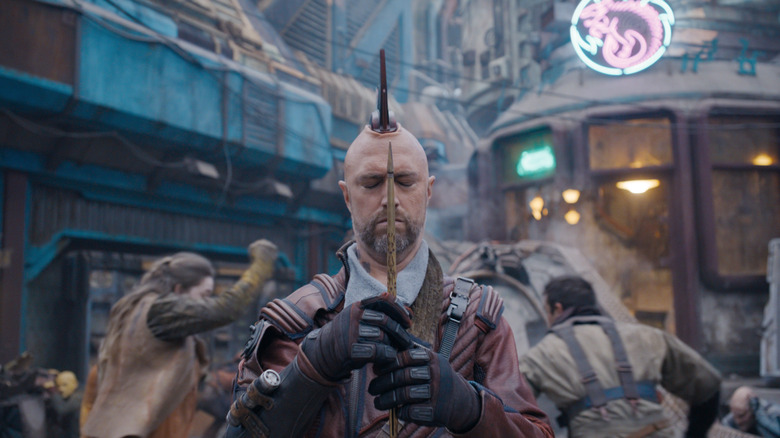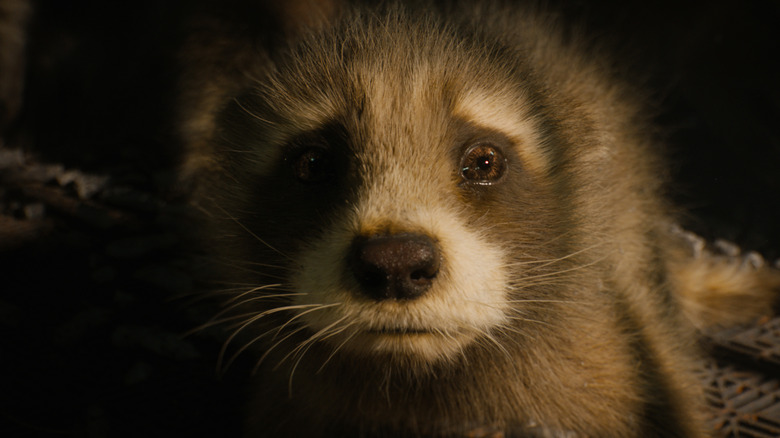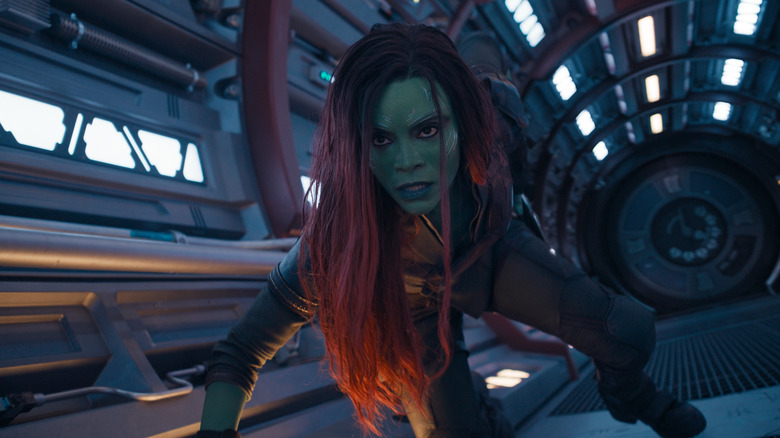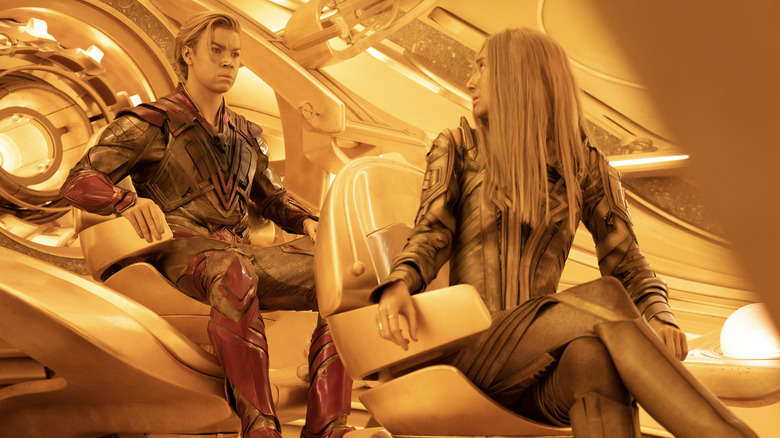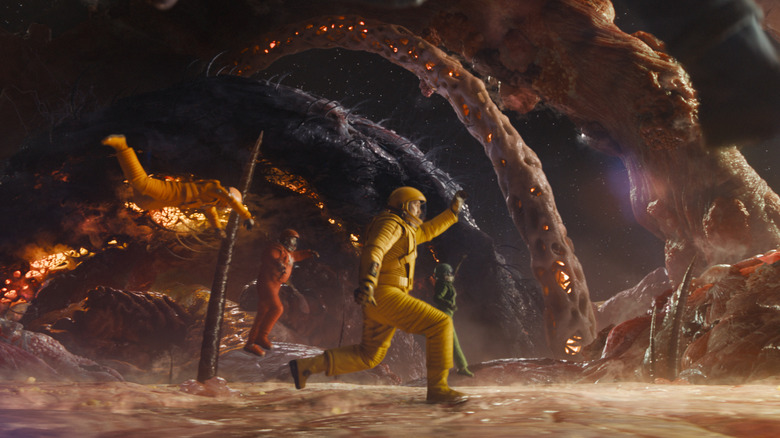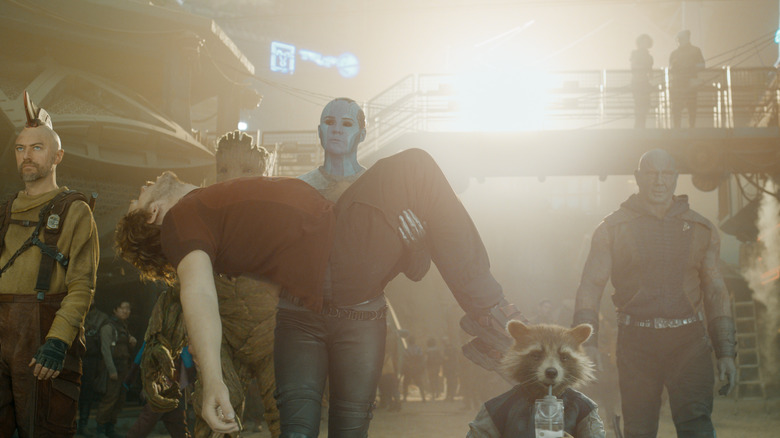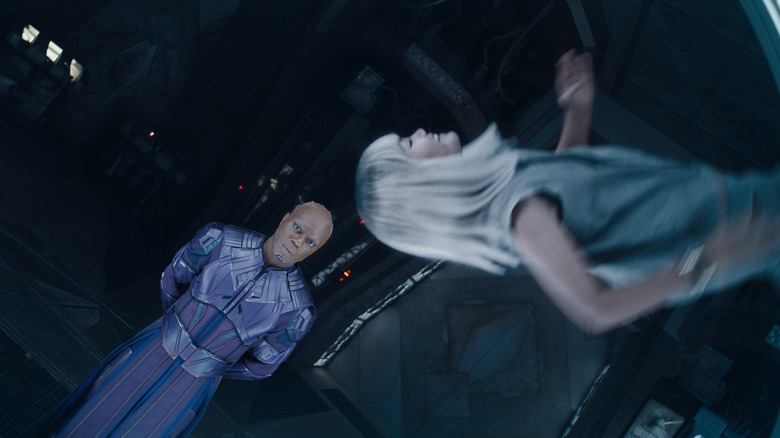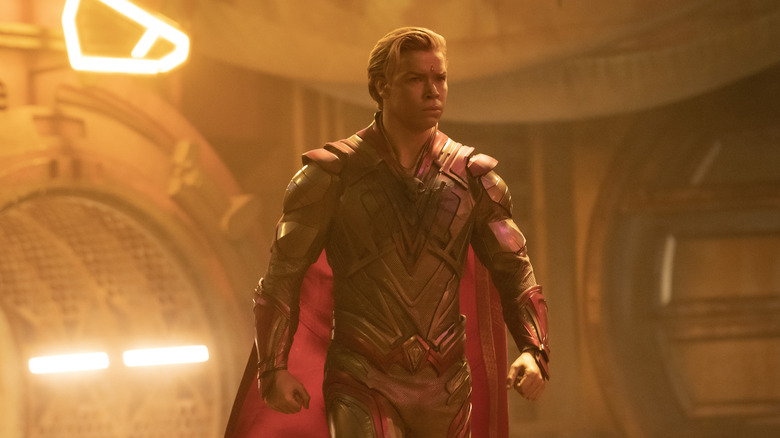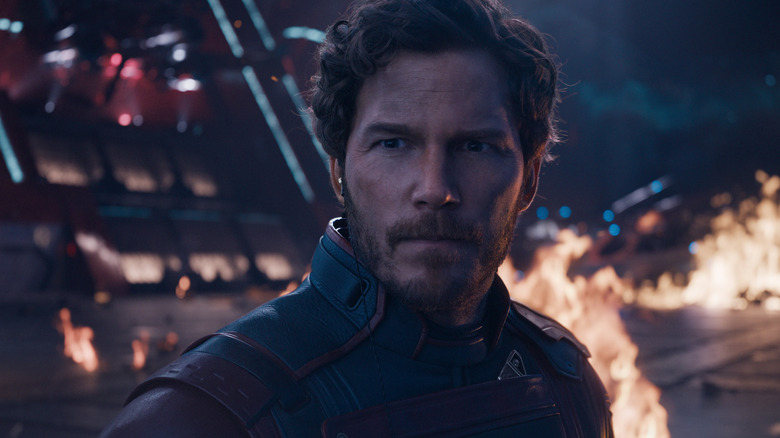The Most Confusing Moments In Guardians Of The Galaxy Vol. 3
The Marvel Cinematic Universe has gotten a lot bigger and a lot weirder since its debut back in 2008 with "Iron Man." That film told a relatively down-to-earth story about a billionaire arms dealer who, after he's the victim of a kidnapping, uses his tech to become an independent counterterrorism agent. It's a plot that could've just as easily appeared in a non-comic book-inspired military drama or espionage thriller. Those genres of films can be confusing in their own right, but they aren't completely gonzo in the way that Phase 5 of the MCU is shaping up to be.
32 movies later, the franchise has ballooned to include myriad types of aliens, sorcerers and witches, and gods, not to mention branching timelines, a multiverse, and hidden dimensions. "Ant-Man and the Wasp: Quantumania" was trippy enough with its unusual-looking miniature beings and its multiplying Scott Langs. But "Guardians of the Galaxy Vol. 3" — which is a better movie overall — tops it in that regard, too.
The conclusion to what's probably Marvel Studios' best mini-franchise is deeply strange and strangely deep. Stakes-wise, it's not among the MCU's most ambitious films (which is kind of refreshing) and it doesn't tie back into too many other MCU properties, other than the previous Guardians installments and the end of the Infinity Saga. On the surface, it's a MacGuffin-driven film about a bunch of friends looking for a secret code. But underneath that surface, "Vol. 3" is creatively and thematically ambitious, with subplots, character arcs, new lore, and emotional beats that take unexpected turns. Audiences likely got writer-director James Gunn's zany and heartfelt big picture, but they may still have questions about these aspects of "Vol. 3."
How did the Guardians end up running Knowhere?
Between the events of "Guardians of the Galaxy Vol. 2" and "Vol. 3," the ever-growing and changing rag-tag team has gotten up to hijinx in several other MCU offshoots. They were near the center of the action in "Avengers: Infinity War" and "Avengers: Endgame," and they appeared briefly at the beginning of "Thor: Love and Thunder." But, chances are, the average MCU fan kept up with those films and the important plot and character developments therein. What's less certain is that everyone who bought a ticket for "Vol. 3" will have seen "The Guardians of the Galaxy Holiday Special," which aired on Disney+ in November of 2022.
That 42-minute romp, which was in essence an extended Kevin Bacon joke, contained two critical pieces of information for the third cinematic installment. First, Mantis (Pom Klementieff) revealed that she's Peter's (Chris Pratt) half-sister. Of more consequence is the fact that, sometime prior to the events of the holiday special, the Guardians took Knowhere off of the Collector's (Benicio del Toro) hands. In the first movie, the inhabited head of a deceased celestial is described as a lawless place of ill-repute where one should watch their wallet. Later, Thanos all but destroys Knowhere in his effort to claim the Reality Stone.
During the holiday special and at the start of "Vol. 3," the Guardians of the Galaxy's day job is guarding (and rebuilding) Knowhere, which has become a refuge community of sorts. That they're creating their own utopian society out of broken people and a broken place is in keeping with the movie's themes, especially when compared to the High Evolutionary's (Chukwudi Iwuji) disturbing concept of utopia that we see later on.
When do the flashbacks take place?
The MCU's timeline has gotten increasingly convoluted, especially in the post-blip era, despite the fact that most of the franchise's stories are told in a pretty straightforward way. "Vol. 3" relies more than usual on a framing device in which we flash back and forth between Rocket's (Bradley Cooper) youth as a captive of the High Evolutionary and his present, in which he's fighting for his life as his friends desperately hunt for the override code that could possibly save him. That structure is extremely emotionally affecting, and the story is well-told enough to follow, but exactly when everything is happening and for how long is less clear.
There are visual markers that let us know some time has passed. We first see Rocket as a kit, then a juvenile. The High Evolutionary has only one tiny silver device on his face as opposed to an entire apparatus stretching it taut. Context clues in the MCU, as well as in basic zoology, provide a range. We meet Rocket in the MCU's version of 2014. "Vol. 3" takes place after the holiday special, which is set around Christmas of 2025.
Since raccoons mature between one and two years (which seems to be about the minimum amount of time he spent with the High Evolutionary), we can guess that Rocket is at least 13 but probably much older. He brags that he's escaped prison on 22 separate occasions, which wouldn't happen overnight. Real raccoons can live to about 16, but his genetic and cybernetic "enhancements" may have given him a longer lifespan.
Is Gamora Gamora?
When we catch back up with Peter Quill, he's still reeling from the loss of Gamora (Zoe Saldaña). Nebula (Karen Gillan) is doing her best to support him through his grief, which is why she fails to mention that her sister is her contact within the Ravagers. Whether this Gamora is Peter's Gamora is played for light humor and heartbreaking drama in "Vol. 3." Many MCU fans will remember how we got here, though some might be a little fuzzy on the details and the in-world mechanics of Gamora's return.
The answer is ... she is and she isn't. A great many of Marvel's Phase 3, 4, and 5 arcs have to do with alternate timelines ("Loki"), universes ("Spider-Man: No Way Home" and "Doctor Strange in the Multiverse of Madness"), and realms or dimensions ("Ant-Man and the Wasp: Quantumania"). Doctor Strange met supers from another universe — 838 — in the Illuminati. Conversely, this Gamora belongs to Star-Lord's universe — 616 — but not his timeline. She came to be when the Avengers pulled off their time heist in "Endgame." The Gamora that loved Peter was thrown from a cliff on Vormir during "Infinity War" so that Thanos could possess the Soul Stone. She's definitely dead.
Then "Endgame" created a new timeline branch and a divergent 616 Gamora with unique life experiences and personality traits. Biologically, she's the same being he fell in love with, but functionally, she's a completely different person. The MCU is often purposefully vague about these distinctions, though, so that they have infinite on top of infinite future character and story possibilities at their disposal.
The High Evolutionary made the Sovereign?
The gold hued race known as the Sovereign is introduced near the beginning of "Vol. 2" when Star-Lord and company are hired to protect their uber valuable Anulax batteries from an Abelisk. They're successful, which wins them the esteem of the Sovereign, who are, we learn, a notoriously haughty people. But Rocket destroys that goodwill almost immediately when he pockets a few Anulax batteries in addition to their payment: Nebula.
"Vol. 2" ends with not one, not two, but five post-credits scenes; the third shows that High Priestess Ayesha (Elizabeth Debicki) has something cooking — a next-gen birthing pod. She says she's designed him to destroy the Guardians after they wronged and embarrassed her, and she adds that she'll call him Adam, which fans correctly took to mean that Adam Warlock's (Will Poulter) arrival was imminent.
But "Vol. 3" gives his backstory — as well as that of the Sovereign themselves — a tweak. We learn that the High Evolutionary brought them into existence as one of his experiments aimed at creating a perfect race. Though "Vol. 2" makes it seem like Adam was Ayesha's idea, she complains that the High Evolutionary took him out of his cocoon too early. This retcon doesn't come out of nowhere. The High Priestess used the word "evolution" in describing Adam's conception in that post-credits scene, and it's worth noting that — while the Sovereign are an MCU invention — the High Evolutionary, Ayesha, and Adam Warlock are longstanding Marvel Comics characters who definitely matter in each other's stories. Totally unremarked upon in "Vol. 3" is the gem beset in Adam's forehead. Canonically, it's the Soul Stone.
What's the Orgoscope and what does Orgocorp do?
When it comes to peculiar celestial bodies, the MCU — which isn't strictly a space fantasy — has franchises like "Star Wars" and "Star Trek" beat. "Vol. 1" had the floating decapitated head that is Knowhere, and "Vol. 2" boasted Ego the Living Planet. Now, "Vol. 3" presents a cosmic mass, unlike anything we've ever seen before. The Orgoscope is an organic, bioengineered entity grown, owned, and operated by the High Evolutionary and his public-facing company, OrgoCorp. It's literally a planet-sized hunk of tissue that happens to house OrgoCorp's headquarters, where the company's daily operations take place and where proprietary information (like, say, Rocket's file) is kept secure. That sensitive intellectual property is guardedor by OrgoSentries, one of whom is Nathan Fillion's frustrated foreman, Master Karja.
A giant fleshy rotating orb with its own atmosphere that also serves as an office building is something to wrap your head around. Less weird but less well-explained is OrgoCorp itself. "Vol. 3" only devotes a line or two to the idea that the High Evolutionary is the nefarious CEO of a shady conglomerate. OrgoCorp's schtick seems to be offering naturally derived body modifications to consumers throughout the universe. There's an element of greenwashing to it all, though, since we know the High Evolutionary is also experimenting with cybernetics and — as he demonstrates when he incinerates his failed experiments — he has a terrifyingly warped moral compass. OrgoCorp's less controversial work covers for and pays for the High Evolutionary's real passion: callously creating and destroying life until it fits his ideals.
Is Star-Lord crushing on Nebula now?
The MCU is infamously asexual. It took 26 movies for two characters to hook up on screen, and even then, what was advertised as a steamy Marvel first turned out to be rather underwhelming. The most enduring romance was between a witch and artificial intelligence. Second place probably goes to Peter Quill and Gamora, and we only got minutes worth of their relationship at the very end of "Vol. 2" and in "Avengers: Infinity War."
This franchise rarely lets could-be couples get together in the first place, and when it does, it doesn't keep those couples together for long. Fans likely went into "Vol. 3" wondering whether the MCU might engineer a way for Star-Lord and alternate timeline Gamora to find love, but instead, James Gunn took this potential subplot in an entirely unexpected direction... we think?
For anyone who wants to see it, there's major Star-Lord and Nebula sexual tension throughout "Vol. 3." Alternate Ravager Gamora herself picks up on it, after which there's a moment when Quill seems to realize he does find Nebula attractive. Nebula is, of course, hard-shelled and combative as ever, and her response to his attempt at flirtation is one of the movie's better jokes. But her empathetic attitude toward him early on combined with the closure Peter gets when he says goodbye to Gamora leads us to wonder: are we supposed to be shipping Star-Lord and Nebula now? "Vol. 3" is ambiguous enough to support both sides of this debate.
Who are those kids?
When Drax (Dave Bautista), Mantis, and Nebula get stuck on the High Evolutionary's pyramid-shaped vessel, they discover an onboard prison full of fair-haired children. Mantis and Nebula struggle to communicate with the scared kids, but Drax — who comforts them by badly imitating a monkey — eventually reveals that he speaks their language. After Peter is able to save Rocket with the source code stolen from implanted external storage in the head of one of the High Evolutionary's lackeys, the Guardians' mission becomes rescuing the innocents trapped on that ship.
The film never provides the name of a race or a planet from which they might hail, but two clues help to fill in the blanks. In a prior scene, the High Evolutionary watches a blonde girl run circles in a human-sized hamster wheel. He's annoyed that, while he's been able to engineer negative qualities out of her, he hasn't been able to replicate Rocket's superior intellect. Since the High Evolutionary's methods seem to be capturing specimens and rapidly evolving them or breeding them through birthing pods, these children (and possibly their ancestors) are basically the High Evolutionary's latest guinea pigs.
In the mid-credits stinger, one of those kids (the same one that was jogging on that hamster wheel, in fact) has joined the current iteration of the Guardians team led by Rocket Raccoon. The others refer to her as Phyla (Kai Zen). This is almost definitely Marvel Comics' Phyla Vell, a genetically engineered super-humanoid and the daughter of Mar-Vell who does eventually join the Guardians of the Galaxy.
How did everybody survive their grave injuries?
Superhero movies usually feature over-the-top fights that would absolutely prove fatal to normal humans, but "Vol. 3" takes this idea to the extreme. Because it is advertised as the finale of the "Guardians" trilogy and because the trailers and press tour seemed to foreshadow some tissue-worthy tragedy, most fans fully expected a fan-favorite protagonist would die. Instead, "Vol. 3" contains multiple fake-out deaths, and no main character bites the bullet.
Rocket's near-death experience is not only plausible, but it also serves as the catalyst for the whole plot. Drax takes two deadly blasts to the chest but manages to recover (thanks to the same med packs that wouldn't work on Rocket, we can guess). Harder to believe are Groot (Vin Diesel), Adam Warlock, and Star-Lord's miraculous recoveries. Groot is decapitated in a duel with Adam Warlock on Knowhere, after which the Sovereign takes Nebula's comically-large energy blade to the chest and collapses, lifeless. And Quill succumbs to the elements (yet again) in space. How did they survive?
Groot has sped-up regenerative powers, especially as they pertain to his limbs. Since he wasn't completely destroyed, he simply had to regrow the plant matter that makes up his trunk of a body, and he remained the same Groot (which wasn't the case after "Vol. 1"). The MCU's Adam Warlock is a closer-to-perfect Sovereign 2.0 with upgrades (and that gem in his forehead) that other Sovereigns don't possess, like superior durability and healing. In the comics, he can be killed but can't actually die. At the end of the movie, he imparts this quality to Peter, who really was a goner, to bring him back to life.
What does Star-Lord will return mean?
"Vol. 3" was meant to be the capstone to these superheroes' shared story, and based on all the tearful goodbyes in the film's final moments, it probably is ... for some characters and actors. Gamora returns to the Ravagers, where her smile makes it clear that's where she belongs. Mantis, now commanding a pack of three tamed Abelisks, goes off to find herself. And Drax adopts the children that had been the captive subjects of the High Evolutionary.
All three actors have indicated they're unlikely to return to the MCU. but the mid-credits stinger teases a new Guardians team moving forward, led by Rocket, and made up of Groot, Cosmo (Maria Bakalova), Kraglin (Sean Gunn), Adam Warlock, and Phyla. Whether we ever actually see this team in action is yet to be determined, but at least in fans' imaginations, they're out there doing a little bit of bad and good.
Peter Quill, however, returns to Earth to reconcile with his grandfather, Jason. Curiously, there's a tacked-on title card that reads, "The Legendary Star-Lord will return," at the end of the film. That seems to indicate Chris Pratt will be reprising the role in subsequent MCU projects. With Gunn having migrated to DC, the future of the "Guardians" sub-franchise is up in the air. But Star-Lord is a marquee MCU character and Pratt is as bankable as ever a star. Since he's back on his home planet, it's possible we'll see him again in a standalone film or alongside Captain America or Deadpool, but it's just as possible that he'll re-take to space, where we could meet up with him in the announced "Avengers" movies slated to premiere in 2025 and 2026.
